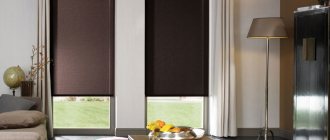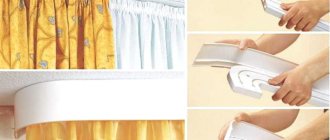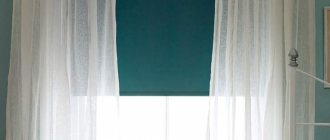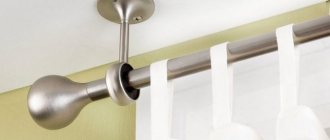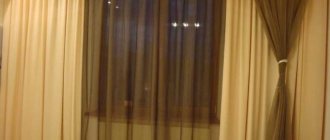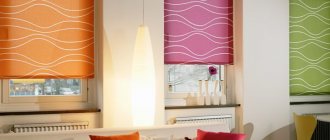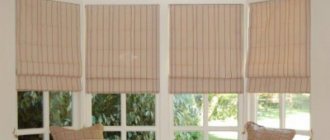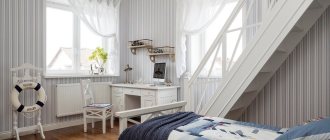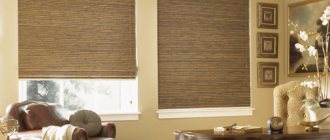Curtains on the ceiling cornice
Many people are interested in how to hang curtains on a ceiling cornice. The main purpose of the products is to protect a person’s internal space from the penetration of prying eyes, bright sunlight and cold air. The products also serve as decoration for windows and doors of rooms and create coziness in the home.
This article will tell you in detail how to choose and hang curtains for ceiling cornices.
How to hang curtains on a ceiling cornice using hooks
The upper part of the hook is attached to the grooves of the cornice, the lower part is attached to the eyelets on the curtains. How to hang a curtain correctly:
- Make loops on the top of the fabric at a distance of approximately 10 cm from each other.
- Insert the narrow bottom part of the hooks into the eyelets.
- Remove the stopper on the curtain rod, insert the upper parts of the hooks into the grooves.
- Distribute the fasteners along the “track”, install the clamp between the first and second elements.
Fastening with hooks to the cornice
Braid
Curtains with braid are very easy to hang. Sewn to the top of the fabric, the curtain tape is equipped with sewn-in threads along its entire length to create a beautiful gather and loops for hooks. This method saved the owners from the painful process of draping curtains by fixing them on the cornice. With the help of this tape, the finished canvas, with folds laid, with hooks or clips hung at the same distance, is attached to the holder. Figuring out how the curtains are attached with tape to the ceiling cornice is not difficult. To do this, you need to buy a ribbon that matches your fabric, sew it to the top of the fabric, pull it to the desired length, straighten the folds evenly, hang hooks with wheels or rings with hooks, the more often, the better for the fabric, and everything is ready, you can string it on the holder .
There is another way to hang curtains in even folds on the ceiling cornice, without tightening the tape. In this case, too, hooks are first put on, and then the curtain product is hung on the ceiling holder. The curtain material should be 1.5 times the length of the cornice, plus 10 cm on both sides to make technical folds, and 4 cm on the sides to bend the edges.
The need for technical hems lies in the fact that the product will look better if the side seams are not visible. But you don’t have to do the twists. Now, in detail, how to properly hang hooks for this method. We step back 10 cm from the side, insert a hook, it will be considered the outermost one. Next, we make a technical twist, wrapping the curtain along the hook, and put the next hook on two loops at the same time, connecting the outer one with the one opposite it. Using the next hook, we pick up a loop closer to the hem and a loop after 5 cm. As a result, we get a small fold. We do this across the entire width of the fabric, that is, we put the hooks on every 10 cm, and the distance between the loops on one hook corresponds to 5 cm. From the other edge of the product we again perform a technical fold.
As a result, we have small but evenly laid folds across the entire width, and if the canvases are moved apart, the folds become deeper.
This method is suitable for both curtains and tulle, because with a small width of the fabric you will always get evenly made folds.
How to hang curtains if there is no room for a curtain rod
Use a barbell and hooks. Place fasteners on each side of the window opening and place the crossbar on them. You can hang the canvas in any convenient way: on hooks, decorative ribbons, loops.
Curtain rod
The second option is a telescopic cornice in the form of a tube with dense tips. It does not need to be mounted - the product is attached using the spacer principle.
Advice! If you have light, fluffy curtains, you can install ceiling holders and stretch a string between them. Curtains with eyelets are ideal for string cornices.
Types and design
The modern market offers a huge variety of window curtains.
They can be:
- During the day. When making them, lighter and more airy fabrics are used.
- At night. Made from dense, heavy fabrics.
According to the appearance and design of the product, there are:
- Classic. Their peculiarity is that they are made of soft textiles that create vertical waves. When choosing a canvas, you should take into account its main characteristics, which include:
- fabric density. It can range from translucent to heavy, coarse materials;
- assembly factor. In this case, the width of the fabric is taken taking into account two indicators: the length of the cornice and the width of the fabric for it. If there are drawings on the product, the coefficient is chosen to be no more than 1.5 so that the decorative decoration is positioned more correctly. For plain curtains, the gathering factor should be from 1.5 to 3;
- the presence of lining material, which makes the curtains heavy and does not let in daylight. In this case, two qualities of curtains are conveniently combined: lightness, beauty of texture and screen quality;
- whether there are tiebacks, they allow you to assemble the curtain in the right place, which will complement the overall decor of the product.
Translucent classic products on the ceiling cornice
- Austrian. The structure of the material is reminiscent of Italian and French curtains. Lush folds and original curves create a harmonious balance. A lifting mechanism with an adjustment system makes it convenient to use such curtains. With a combination of French pomp and Roman severity, Austrian curtains can be used both in luxurious mansions and in small rooms. When choosing curtains, you should take into account some of their features:
- products acquire airiness thanks to translucent and light materials, such as silk, chiffon, tulle, veil, taffeta and organza;
- The size of the drapery folds depends on the amount of fabric. The ratio of folds to the height of the window opening should be 1:2. In the usual version, to raise the curtain, 50 centimeters of canvas are added to the height of the window opening;
- Drapery ribbons are sewn to the curtains, which divide the fabric into the required number of scallops.
Austrian
- French, otherwise called “marquises”. When assembled, they refer to cascading curtains that resemble flowing water. Effectively folded folds very attractively decorate the window opening and give a romantic or aristocratic look to the entire interior. Awnings should not be used on windows that open. This will create some inconvenience when moving the canvas, but they are ideal for decorating blind windows in the upper part. In this case, the curtains can be raised to the desired level and fixed.
French
- English or London, the curtains look impressive both raised and lowered, thanks to their special cut. When raised, the fabric folds into voluminous garlands, thanks to the large counter folds on the curtains located on the sides. They harmonize well with lambrequins. The presence of large and contrasting patterns emphasizes the originality of the outline of the curtains, small patterns merge and reduce the volume. An interesting solution is to select the color and pattern of curtains to match the wallpaper. All sorts of combinations of checks with plain fabric and stripes with floral prints are also used.
English
Tip: Soft fabrics are used to make English curtains; they lend themselves well to draping.
- Roman or Italian. Curtains are ideal for any interior. They are appropriate in residential and domestic premises, unlike other types of curtains. The canvas is made from fabrics of different textures and composition. In modern homes, Roman blinds are often combined with straight classic products and combined with voluminous lambrequins. Italian curtains are single-piece fabrics. The strips are sewn horizontally on their reverse side, and special rings are attached to the vertical edges. Thanks to this design, the fabric can rise and fall freely. When lifted, neatly folded folds are formed. When closed, the curtains fit tightly to the window opening. Nowadays, remote control of Italian curtains with an electric motor is common.
Roman
- Japanese. They are suitable for home owners who love simplicity, elegance and versatility. Such curtains are designed to decorate window and door openings, when dividing a single space into separate zones. As shown in the photo.
Japanese
- Louvered. These are efficient and compact strips of fabric, metal or plastic, connected by cords and chains into a mechanism for lifting or extending them. There are several types of blinds:
- vertical;
- horizontal;
- roll;
- roller shutters
All types are suitable for residential, office and medical institutions. They are made from practical polymers and impregnated with hypoallergenic and bactericidal compounds. They are easy to clean and have independent fasteners. They can be fixed to ceilings, walls and directly to the windows themselves.
There are two types of lifting mechanisms:
- mechanical. The canvas moves due to threaded cords along the side guides;
- auto. Using a button or remote control, the electronic control of the motor is activated, which moves the curtains.
Where are curtains attached to a suspended ceiling?
It is better to provide a cornice at the stage of installation of the ceiling surface. Options:
- Open method. A block is fixed under the ceiling sheet, to which the structure will then be attached.
- Hidden way. In this case, there remains a niche between the suspended and main ceilings. This is the space for installing the cornice.
Open cornice
Hidden cornice
Advice! If you forgot to provide provisions for the cornice, use a rod with wall brackets. This system will avoid stress on the ceiling canvas.
Ties
Curtains with ties can be made from any fabric. In this option, hanging the curtain from the ceiling cornice is done by tying ribbons sewn to the top of the product into a knot or bow. To hang curtains correctly, you need to take into account that the denser and heavier the fabric, the thicker and wider the ties must be, so that they can support heavy fabrics. It is especially good to use this method for airy natural tulle in light shades or curtains with a pattern of flowers, when bows will complement the lightness of the composition. Such a curtain will decorate the bedroom, kitchen, and will look good in a girl’s room, bringing a touch of romance and lightness.
Assembly options
Depending on the width and density of the tape, it can be used to create a number of different patterns, from the most ordinary waves to real masterpieces. The most popular are:
- The simplest option is designed to obtain uniform folds. As a rule, the assembly coefficient in such a model is 1.5. The simplest and most uncomplicated pattern, which also does not require a lot of fabric. Even the narrowest ribbon is suitable for creating such drapery. It will be most convenient to hang tulle on such a curtain tape;
- Bow fold. It looks like single or double bows located close to each other. The minimum coefficient in this case is 2.5, sometimes it can reach 3;
- Glasses. Very refined and sophisticated look of folds. The fabric, gathered at the bottom with a triple tuck, forms something like a glass at the top. To create them, you need a tape with two rows of cords and a coefficient of 2.5;
- Buffs. A rather lush and original pattern in the form of several rows of diamonds can be formed only with the help of a wide ribbon with at least 4 rows of cords. Looks beautiful on thick expensive fabrics. The assembly factor also starts from 2.5;
- The most expensive fabrics, but at the same time incredibly elegant and sophisticated, are French or triple folds. Here the coefficient is 3, that is, to get 1 meter of curtains draped in this way, we must purchase 3 meters of fabric. Typically used on thick curtains. Has several rows of pockets for adjusting the seat height;
- Waffles or ruffles add pomp and airiness to the interior; counter folds, reminiscent of small water ripples, also have a similar effect. To create them you need a thick and wide tape with a coefficient of 2.
Classification
Curtain and curtain hooks for wall and ceiling cornices are distinguished by material of manufacture and design. For their manufacture use:
- high quality plastic;
- metal (mainly brass, aluminum and steel);
- metal-plastic is a modern combined material.
Plastic options are suitable for light and medium weight curtains. In addition to the most affordable price among products of this type, they have another undoubted advantage - noiselessness when moving along the ledge. But over time, plastic hooks wear out and lose their shape, which entails a violation of the overall composition. This is caused by the curtains sliding off their hinges due to deformation of the hooks.
Hooks for curtains in the bathroom can be chosen either plastic or metal-plastic, or metal, chrome-plated on the outside, as in the photo below.
Metal curtain hooks are more expensive, but also more reliable. They do not deform during use and firmly fix the curtain fabric, preventing it from sliding down. Their disadvantage is noise. In addition, the characteristics of this fastener very much depend on the quality of the metal. If the fasteners are made from cheap raw materials or with poor technology, over time they will rust and ruin the curtains that are hung on them. It is better to give preference to metal products with anti-corrosion coating.
Metal-plastic is the optimal material in terms of price and quality. It combines the advantages of the two previous types and does not have their disadvantages. Curtain hooks made of metal-plastic are more expensive than plastic products, but cheaper than metal ones, are absolutely silent and keep their shape perfectly throughout their entire service life.
There are different types of curtain hooks depending on their design. They are:
- Closed and open. Hanging curtains on open models is quicker and easier, but there is a possibility that the fabric will slip off the hook, for example, if you pull it sharply. Closed hooks are equipped with a latch. Thanks to this, the loops do not slip off their folded part. It’s also convenient that you don’t need to remove them from the curtains when washing them.
- Hidden or decorative. Decorative hooks for curtain rods are used in cases where the interior concept requires or allows the presence of additional accessories that attract attention to the curtains. But still, standard fastenings, invisible, hidden in the folds of fabric, or under the console, are more popular.
- Transitional and basic. The main models include those that serve as independent direct fastening. Transitional hooks-clamps connect loops, clips, eyelets and are used mainly on round cornices.
In order not to spoil the presentable appearance of the curtains due to possible deformation or corrosion of the hooks, it is recommended to change them every two years.
What nuances to pay attention to when choosing
When choosing hooks for curtains and drapes, you need to take into account their compliance:
- weight of the curtain composition;
- frequency of its operation (moving or hanging stationary);
- design of curtains and interior in general;
- loop size;
- type of cornice.
Thus, before hanging curtains, you should first find out how long they will last without breaking or deforming and securely holding the curtains in the required position. In addition, you must take into account the type of cornice. For example, products attached to rings are perfect for round cornices, while bohemian consoles are best complemented with plastic hooks, which are designed for curtains with rollers.
There is no need to save on curtain accessories unless absolutely necessary. It would seem that fastening is a trifle, but it can also nullify all efforts to create a harmonious environment. Therefore, despite the fact that hooks are very convenient and versatile, before choosing them or any other method of hanging curtains on a cornice, you need to think through the entire design of the curtain composition and its compliance with the overall style of the interior.
Variety of assortment
Manufacturers offer hundreds of different options for curtain hooks. But among them there are several main types:
- Plastic, metal and metal-plastic.
Plastic models are characterized by low price, lack of noise when moving curtains along the curtain rod guides, and resistance to external influences, due to which they can be used not only in residential premises, but also in the kitchen or bathroom. However, they also have some disadvantages. Over time, under the influence of the weight of the canvas, they become deformed, easily break if handled carelessly, are not able to withstand heavy weight, and therefore are only suitable for attaching light curtains.
Types of curtain fastenings
Today there are many devices and methods on the market that allow you to securely hang curtains.
Curtains can be secured using:
- eyelets;
- rings;
- hooks;
- braids;
- drawstrings;
- loops and ties;
- clip.
The choice of fastening mechanism is made taking into account the individual preferences of the owner, the type of cornice, and the characteristics of the opening being decorated. One of the most common types of accessories for fixing canvases are hooks.
These products are easy to install and use, fairly inexpensive, reliably hold the material, and come in a variety of shapes and colors.
Rings
Ring curtains are made from various fabric textures and are attached to the holder using rings. Hooks, clips, clips can be attached to the rings; they are also called “crocodiles”. Since clips will not be able to support heavy fabrics, this method is acceptable for lighter fabrics.
When hanging or removing tulle or curtains, be careful, because the teeth of the crocodile clips can accidentally damage the fabric.
In order for the curtain to hang in beautiful folds, simply attaching it to the cornice is not enough. Folds can be made while sewing, or while hanging the curtains from the ceiling.
In order for curtain products to look beautiful and rich, it is necessary that there is enough material for sewing them. Usually they take 1.5-2 times, or even 3 times more of the required width.
The curtain fabric should protrude beyond the edges of the window by no less than 15-20 cm and be several centimeters longer than the curtain. Ideally selected sizes will decorate the window opening, adding completeness to the interior.
How to correctly calculate the length of tulle?
A simple rule is to multiply the length of the cornice strip by two - you get the desired figure. The dimensions of the material are calculated based on the length and width of the window. Be sure to take into account folds, the so-called gathers of fabric, and leave a margin for them. It is better to make all measurements using a tape measure.
Interesting materials:
How to remove your number from the spinning top? How to remove your view on Instagram? How to remove your wall in Rasta? How to remove folding in Word? How to remove Huawei T9? How to remove text from a table? How to remove text under a cut in LiveJournal? How to remove text in Photoshop? How to remove textures in DayZ? How to remove a theme on Samsung A10?
